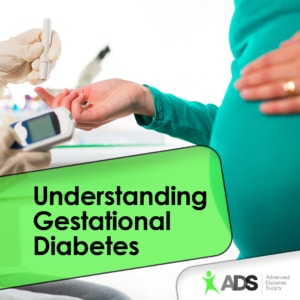
Being pregnant can be exciting, but it’s crucial to make sure you’re getting the medical attention you need for both your health and the health of your new child. That includes keeping a close eye out for diabetes symptoms – even if you didn’t have this disease before getting pregnant.
Whether you’ve been managing diabetes for years or haven’t given much thought to this condition before now, it’s a good idea to know the basics of diabetes and pregnancy. Here, you’ll find our complete guide to this topic.
Pregestational vs. Gestational Diabetes
First of all, you’ll want to know the differences between pregestational diabetes and gestational diabetes:
Pregestational Diabetes
Though you may not have heard about “pregestational diabetes” before, you’re already familiar with this concept. That’s because pregestational diabetes is simply any type of diabetes that occurs before pregnancy. This category can include type 1 diabetes, type 2 diabetes, and prediabetes that later developed into type 2 diabetes.
By definition, if you had pregestational diabetes, it was already diagnosed before your pregnancy. As a result, there’s a good chance that you already have some idea of how to manage whatever type of diabetes you have.
Gestational Diabetes

The term “gestational diabetes” refers to a type of diabetes only diagnosed in expecting mothers. Though the precise cause of gestational diabetes is unknown, it has some relationship to fluctuating hormone levels in pregnant women and not being able to make enough insulin during pregnancy, causing insulin resistance. This will affect blood glucose management, which can trigger this form of diabetes.
Gestational diabetes is unique in that it has no actual telltale symptoms. In fact, most women who develop gestational diabetes exhibit no symptoms at all. While it is possible to experience symptoms like excessive hunger, high levels of thirst and a frequent need to urinate due to gestational diabetes, you won’t need to rely on these symptoms to get a diagnosis. All pregnant women receive testing for gestational diabetes between their 24th and 28th weeks of pregnancy.
The Importance of Blood Sugar Control During Pregnancy
Regardless of what type of diabetes you have, you’ll need to pay close attention to your blood glucose levels while you’re pregnant. Blood sugar control is always a priority for people with diabetes, but it’s even more essential during pregnancy for several reasons.
When you’re pregnant, you don’t just have to manage your own health – you also need to take steps to protect the health of your unborn baby. That includes diabetes management since uncontrolled blood sugar can impact your child’s well-being, too. In the first trimester of your pregnancy, elevated blood sugar levels due to type 1 or type 2 diabetes can lead to higher congenital disability and miscarriage risks. (Gestational diabetes isn’t a concern at this point since it develops at a later point in pregnancy.)
In later months, high blood sugar levels may result in fetal macrosomia – that is, giving birth to a larger-than-average baby. That can cause additional problems down the road, possibly including shoulder dystocia and fractures. You might also need a C-section in this scenario. Home delivery isn’t generally recommended for pregnant women with diabetes because of the risks mentioned above.
If you aren’t pregnant but have pregestational diabetes, the best way to lower your chances of diabetes-related pregnancy problems is to use contraception and get your blood sugar under control for three to six months before conceiving. If you use oral agents for diabetes control, discuss with your physician about switching to insulin – some oral agents are contraindicated in pregnancy.
How to Manage Diabetes While Pregnant
It’s essential to take the risks posed by pregestational and gestational diabetes seriously. Still, some simple steps can reduce your risk of diabetes-related pregnancy complications:
Know Your Blood Glucose Targets
At the heart of any blood sugar management strategy is an understanding of your blood glucose levels. Use a reliable blood glucose meter to check your blood sugar regularly. Your healthcare team will help you find your blood sugar targets, but target levels that are common for pregnant women with preexisting or gestational diabetes include:
- 95 mg/dl or less (fasting, before meals)
- 140 mg/dl or less (one hour after meal)
- 120 mg/dl or less (two hours after a meal)

Eat a Healthy Diet
When you’re pregnant, the usual advice for building a diabetes diet still applies. Some of the most common tips are eating a balanced selection of nutritious foods, controlling your portion sizes, watching your salt intake and avoiding processed grains, fats, oils, and sweets.
However, you’ll also need to remember that you will need more calories a day while pregnant. The recommended requirements are to increase calories by at least 300 calories plus per day between the fourth and ninth months of pregnancy. Pregnant women have a recommended daily caloric total of about 2,200 to 2500 calories per day. See a Registered Dietitian to plan your diet.
While you’re pregnant, it’s a good idea to get between 40 and 50 percent of your daily calories from healthy, complex carbohydrates. If you eat too many carbs, blood sugar management will become more complex, but not getting enough carbs can also cause problems. Eat fresh vegetables, whole grains, low fat dairy products and high fiber foods.
Continue to Get Moderate Physical Activity
There is good evidence showing that in gestational diabetes cases, the women affected by this type of diabetes can control their condition solely through lifestyle changes. Regular exercise is a highly effective way to lower your blood sugar, so try to get moderate physical activity most days without overdoing it.
Take Medications As Needed
You may not be able to manage gestational diabetes on your own, or you may need medications to control type 1 or type 2 diabetes. Discuss your options with your healthcare team. Either way, insulin is the most common medication for pregnant women with diabetes, but other options include glyburide and metformin.
Keep an Eye on Your Diabetes Risk Post-Pregnancy
Unlike type 1 and type 2 diabetes, gestational diabetes isn’t permanent. Most women with gestational diabetes find that this disease goes away after their pregnancy, but you’ll need to get a blood sugar test from your doctor to be sure. This test usually happens between six and twelve weeks after you give birth.
But even if your gestational diabetes disappears, you’ll need to monitor your diabetes risk in the future. About 50 percent of all women who develop gestational diabetes are diagnosed with type 2 diabetes 5 to 10 years after pregnancy. It is recommended to reach a healthy body weight after delivery. And it means you’ll need a diabetes risk assessment every one to three years depending on the results of your assessment. It may be inconvenient, but it will help you ensure your blood glucose levels stay where they should be.
Whether you need diabetes supplies for a few months or the rest of your life, you shouldn’t order them from just any company. ADS can help you get all the diabetes supplies you need at an affordable price – not to mention our unmatched customer service. Start shopping for our blood glucose meters, insulin, and other supplies today!
